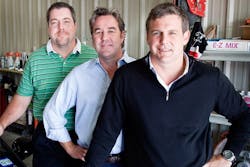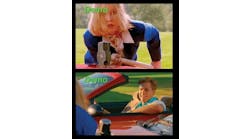The words “shop transformations” bring to mind the latest trends in collision repair: waterborne paints, some sort of lean method, fast cycle times, new compressors, advanced software. But it’s important to remember that true transformation also incorporates the customer.
“It’s a service business and you’ve got to try to make your customers your own customers because they are also the insurance company’s customers and dealership’s customers,” says Ken Hanley, co-owner of four Hanley Bros. Auto Specialists locations in Houston.
FenderBender checked in with three shop operators who have made investments to bring about major changes through manufacturer certifications, adding mechanical services, and automated parts ordering—transformations that improved the business for their customers, their employees and the bottom line. The common thread between all three: along with their operational changes, they also made improvements to their customer service. And reaped the benefits.
The Shop: Hanley Bros. Certified Collision Group
The Transformation: Manufacturer certification and free training
For Ken and John Hanley and James Brown, owners of Hanley Bros. Certified Collision Group in Houston, being manufacturer certified was the next step needed for continued growth. Though the idea is a simple one, actually getting certified isn’t, says Hanley.
–James Brown, chief operating officer of Hanley Bros. Certified Collision Group
Being manufacturer certified means getting access to online video procedures, having positive relationships with dealers and traveling around the country for training, says Brown, chief operating officer of the shop’s four locations and president of the Houston Auto Body Association. But it also means having deep pockets for travel, finding a local dealership that doesn’t have a repair center in-house, and being persistent with local dealerships, says Brown, who has been building relationships with local dealerships for nearly a decade.
“We’ve grown by leaps and bounds,” he says of the shop’s performance after getting certified by five high-end European manufacturers. Brown was originally certified by BMW, Jaguar, Audi and Mercedes-Benz when his shop, Rapid Body Works, merged with Hanley Bros. Auto Specialists to create Hanley Bros. Certified Collision Group. The four Hanley Bros. shops have been certified by Aston Martin, BMW, Jaguar, Land Rover and Mercedes-Benz for the past five years. Recently, one of the shops became the first Porsche-approved collision repair center in Texas, and their north location is the only Audi Authorized Collision Repair Center in Houston.
The certification process includes the following steps:
• Build a relationship with a dealership.
• Check out manufacturer websites for an application and requirements, such as basic equipment required for certification.
• Become sponsored by the dealership.
• Go through manufacturer training.
• Pass annual audits performed by the manufacturer.
Becoming manufacturer certified is worth it if you’ve got the patience and money. Hanley Bros. certifications have helped it grow its revenue from $7.3 million in 2009 to a projected $14 million in 2010, says Hanley.
“You’ve got to be willing to invest back into your company and sacrifice for your company,” says Brown.
Hanley Bros. created photo books of all the repair processes they use so their technicians know exactly what to do. The books serve another purpose: they also show insurers exactly what is needed for each car repair.
By using the books, “we can say, ‘This is exactly what needs to be done in this situation.’ We’ve found that when we explain to an insurance company why we’re asking for what we’re asking for they will understand,” says Hanley. “They want to get the car fixed cheaper, but that’s not always what’s best for the customer.”
The Shop: R&R Collision Center
The Transformation: Creating a one-stop shop
When William Ruttkofsky opened his own shop two years ago, he was nervous about making a profit. “I left a job as a bodyman making close to six figures. When you go into business for yourself, you don’t know if you’ll even have a paycheck,” says Ruttkofsky, who has been in the industry for 20 years. But Ruttkofsky and James Roberts, co-owners of Tecumseh, Mich.-based R&R Collision, have seen an almost 40 percent increase in revenue in the last year. The shop’s revenue in their second year was about $1.5 million.
–William Ruttkofsky, co-owner, R&R Collision
Ruttkofsky attributes much of his revenue increase to making the 11,000-square-foot shop full-service and lots of word-of-mouth advertising from happy customers. “I try to get people to think of me no matter what they need for their car,” says Ruttkofsky.
Whether his customers need new tires, brakes, body work, or an oil and filter change, R&R Collision can do it all. But the shop’s main business is collision repair, says Ruttkofsky. “Since they’re already going without their car, it’s pretty convenient for them to get other work done too.”
He offers to do extra collision work on a car at a discounted rate. “We’re already working with the car so if there’s a ding or a dent somewhere else on the car why not sell that at a discounted rate?” And he does, usually around 20 percent off the cost of the repair.
R&R Collision is also doing well because Ruttkofsky lives by the mantra “Don’t get comfortable.” Too often in this industry, shop owners start to rest on their laurels because they’ve been in the business their whole lives, says Ruttkofsky. “There are always improvements you can make.”
Because there are three shops within a mile of R&R Collision, appearance is key to getting customers. The shop has couches, TVs, magazines and a new LED sign in front that advertises specials, which often gets customers’ attention, says Ruttkofsky.
To keep customers coming back, it’s important to have good employee morale because it reflects the shop environment, says Ruttkofsky. “We usually buy lunch once a week for our nine employees,” and if the shop hits its revenue goal for the month (usually around $150,000) Ruttkofsky and Roberts take the team out for dinner.
The biggest key to R&R’s success: Work. “Work attracts more work,” says Ruttkofsky. During slow weeks, employees will park in front so the shop looks busy, because customers are attracted to a busy shop. But that doesn’t happen often: Ruttkofsky hasn’t had a slow week in months.
The Shop: Nagy's Body Shop
The Transformation: Standard operating procedures and automatic parts ordering
Ron Nagy, co-owner of Nagy’s Body Shop in Doylestown, Ohio, initially noticed a need for change when one of his manager’s daughters got a job at Dairy Queen. “She had to watch a video and take a test on how to make a banana split, and we didn’t even have anything like that for repairing a car,” says Nagy. Today Nagy and his brother Dan run five locations and a central office with a call center and express center, while averaging 77 repairs a week combined—and there’s a standard operating procedure (SOP) for every one of those repairs.
“We put together an SOP for everything, from how we order the parts to how we keep the customer informed,” says Nagy. “The SOPs are all written around the customer.”
–Ron Nagy, co-owner, Nagy’s Body Shop
Managers, estimators and technicians access SOPs and repair orders on the networked computers in the shop, says Nagy. That way a manager can set up the job in the front office and signal the technicians in the back via notification on their computer without having to go back and fill them in. Then the technicians log in, denote the job as “finished” on the computer and a pop-up notification shows up on the front office computer.
After streamlining all five shops’ repair process, the shop saw a decrease in keys-to-keys cycle time. Once around eight to 10 days, cycle time is now about five, says Nagy. When the shop met that goal, Nagy started looking at how the shops could be more efficient in other ways.
“One of the biggest complaints in the industry is the ordering process,” says Nagy. Six months ago the shops started using Clip Lizard, an inventory program that automatically tracks and orders products. If someone takes nuts, bolts, clips, sandpaper or masking tape from the back room, they scan the barcode at the computer, and it’s billed to their cabinet or billed to a repair order and then automatically put on order through a jobber. The old way was to wait for a sales rep to come to the shop and take an inventory of what was needed, order it and bring it back, says Nagy. There was no measurement of how much was used and how much it cost before Clip Lizard, says Nagy. Now, the shop is wasting fewer resources and is more organized, says Nagy.
These transformative changes have made communication in the shops better, says Nagy. But these aren’t the only changes Nagy’s has made. They have one central office, which oversees the repair orders. This way no one shop is too busy because they constantly load level to the shop that can schedule it the soonest. The central office also has a meeting room that accommodates all 55 employees for training sessions. “You have to work smarter, not harder,” says Nagy.


